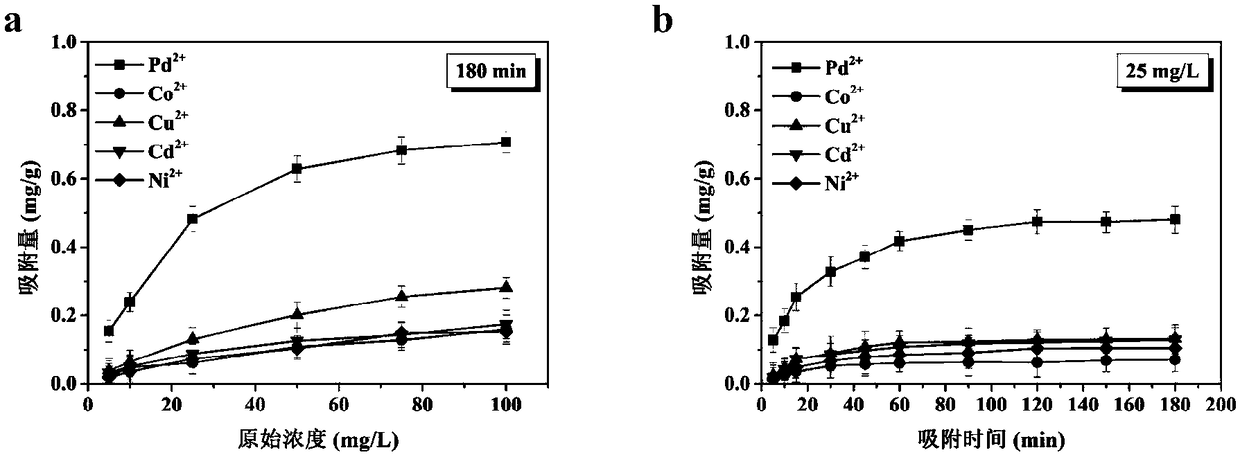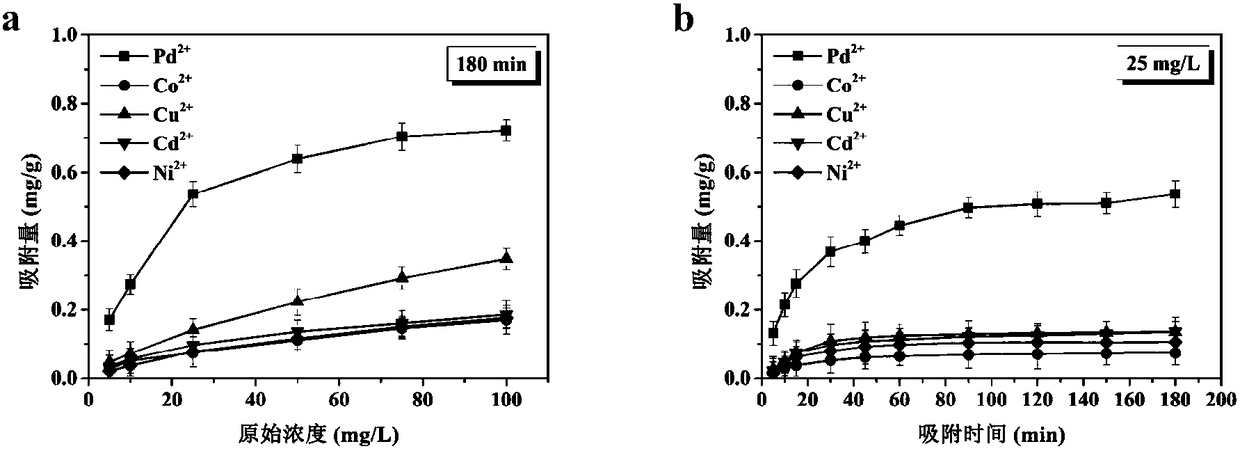Preparation method and application of palladium-ion-imprinted composite membrane for selectively separating palladium ions
An ion imprinting and palladium ion technology is applied in the field of preparation of ion imprinting composite membranes, which can solve the problems of poor membrane flux and low selectivity of ion imprinting membranes, achieve high porosity, facilitate subsequent separation, and have a wide temperature tolerance range. Effect
- Summary
- Abstract
- Description
- Claims
- Application Information
AI Technical Summary
Problems solved by technology
Method used
Image
Examples
Embodiment 1
[0054] Preparation of S1, polydimethylsiloxane (PDMS) base film
[0055] Mix 2.0g of PDMS main agent and 0.2g of curing agent evenly and place in a polytetrafluoroethylene petri dish, put 2 sugar cubes (15mm×15mm×10mm) in the above petri dish, and make the petri dish under vacuum condition The mixed reagent in the medium completely fills the space of the sugar cube through capillary action, and the petri dish is placed in a 60°C drying oven to cure for 10 hours; take out the cured PDMS, wash and soak repeatedly in deionized water at 50°C to remove the sugar cube, and place it at 40°C After drying, the PDMS base film was obtained.
[0056] S2, preparation of modified PDMS membrane (KH570@PDMS)
[0057] Cut the PDMS basement membrane prepared in S1 into long strips (7.5mm×15mm×10mm), immerse 6 cut PDMS basement membranes in a mixed solution composed of 80mL ethanol and 20mL water, add 1mL γ-(formazan Acryloyloxy)propyltrimethoxysilane (KH570), nitrogen gas was passed through t...
Embodiment 2
[0068] Preparation of S1, polydimethylsiloxane (PDMS) base film
[0069] Mix 2.0g of PDMS main agent and 0.2g of curing agent evenly and place in a polytetrafluoroethylene petri dish, put 2 sugar cubes (15mm×15mm×10mm) in the above petri dish, and make the petri dish under vacuum condition The mixed reagent in the medium completely fills the space of the sugar cube through capillary action, and the petri dish is placed in a 60°C drying oven to cure for 10 hours; take out the cured PDMS, wash and soak repeatedly in deionized water at 50°C to remove the sugar cube, and place it at 40°C After drying, the PDMS base film was obtained.
[0070] S2, preparation of modified PDMS membrane (KH570@PDMS)
[0071] Cut the PDMS basement membrane prepared in S1 into long strips (7.5mm×15mm×10mm), immerse 6 cut PDMS basement membranes in a mixed solution composed of 80mL ethanol and 20mL water, add 3mL γ-(formazan Acryloyloxy)propyltrimethoxysilane (KH570), nitrogen gas was passed through t...
Embodiment 3
[0081] Preparation of S1, polydimethylsiloxane (PDMS) base film
[0082] Mix 2.0g of PDMS main agent and 0.2g of curing agent evenly and place in a polytetrafluoroethylene petri dish, put 2 sugar cubes (15mm×15mm×10mm) in the above petri dish, and make the petri dish under vacuum condition The mixed reagent in the medium completely fills the space of the sugar cube through capillary action, and the petri dish is placed in a 60°C drying oven to cure for 10 hours; take out the cured PDMS, wash and soak repeatedly in deionized water at 50°C to remove the sugar cube, and place it at 40°C After drying, the PDMS base film was obtained.
[0083] S2, preparation of modified PDMS membrane (KH570@PDMS)
[0084]Cut the PDMS basement membrane prepared in S1 into long strips (7.5mm×15mm×10mm), immerse 6 cut PDMS basement membranes in a mixed solution composed of 80mL ethanol and 20mL water, add 5mLγ-(formazol Acryloyloxy)propyltrimethoxysilane (KH570), nitrogen gas was passed through to ...
PUM
 Login to View More
Login to View More Abstract
Description
Claims
Application Information
 Login to View More
Login to View More - R&D
- Intellectual Property
- Life Sciences
- Materials
- Tech Scout
- Unparalleled Data Quality
- Higher Quality Content
- 60% Fewer Hallucinations
Browse by: Latest US Patents, China's latest patents, Technical Efficacy Thesaurus, Application Domain, Technology Topic, Popular Technical Reports.
© 2025 PatSnap. All rights reserved.Legal|Privacy policy|Modern Slavery Act Transparency Statement|Sitemap|About US| Contact US: help@patsnap.com



